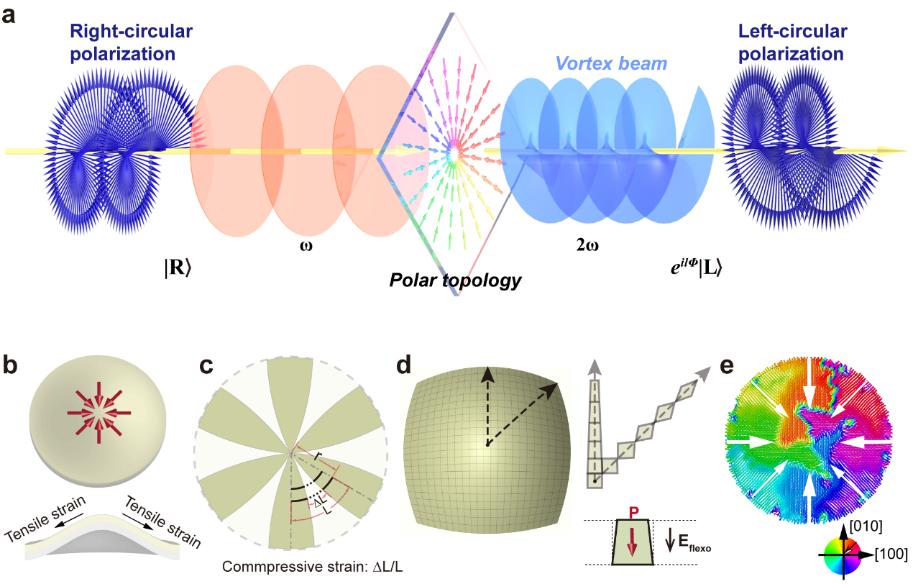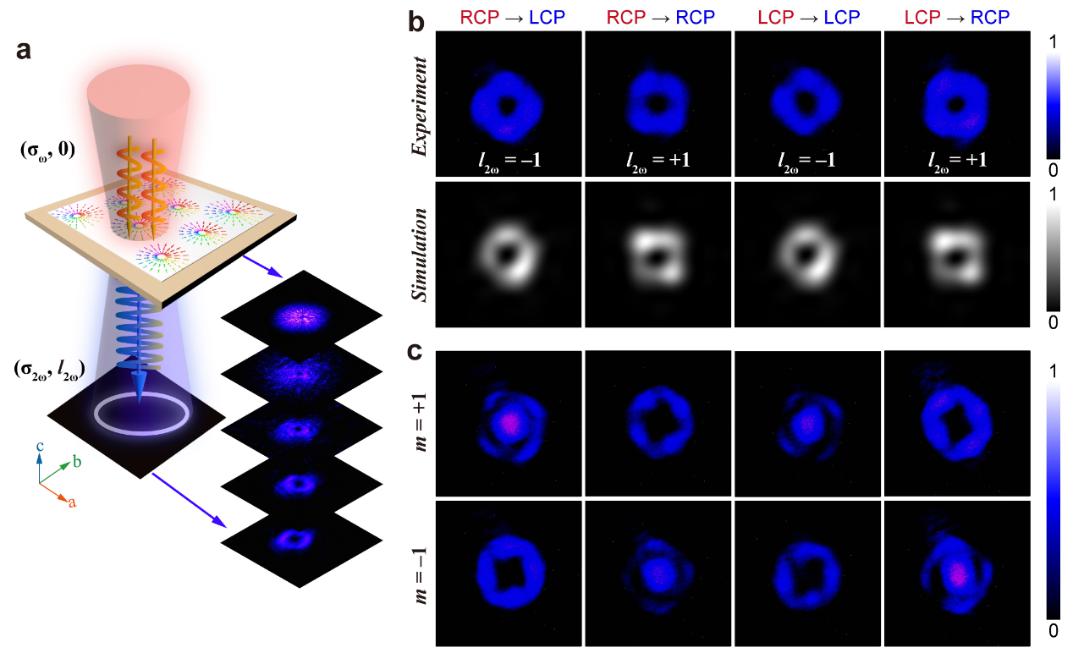Realizing Vortex Light Field Manipulation via Topological polar Structures
Recently, the research groups led by Prof. Yuefeng Nie and Prof. Yong Zhang from the College of Engineering and Applied Sciences at Nanjing University have collaboratively demonstrated a breakthrough in light field manipulation. By innovatively designing and fabricating microscale topological polar structures in ferroelectric oxide thin films, they achieved nonlinear optical conversion from circularly polarized light to second-harmonic vortex light fields, and dynamic modulation of light fields. This work provides novel material design strategies and platforms for multidimensional light field manipulation, with potential applications in high-speed, large-capacity optical communication and integrated photonic devices. The study, titled ‘Ferroelectric Topologies in BaTiO3 Nanomembranes for Light Field Manipulation’, was published in Nature Nanotechnology (DOI: 10.1038/s41565-025-01919-y).
Ferroelectric domain structures in ferroelectric oxides exhibit diverse topological configurations of dipoles, which are stable at the nanoscale and tunable by external fields, demonstrating significant research advancements in high-speed, low-power, high-density nonvolatile memory and terahertz light absorption. Through systematic analysis, the research team innovatively proposed that leveraging the spatial dipole arrangements of topological polar structures and the material’s nonlinear optical properties could enable precise phase modulation of electromagnetic fields, thereby manipulating the orbital angular momentum (OAM) of light, as illustrated in Fig. 1a. Since OAM provides an additional degree of freedom for information encoding beyond conventional amplitude, phase, and frequency, this capability to design and control OAM via polar topologies holds promising potential for the development and application of high-speed, large-capacity optical communication systems.

Figure 1. Schematic illustrations of topological polar structure and its application in light field manipulation. (a) Vortex light field modulation via topological polar domains. (b-d) Mechanisms of dome-shaped 3D structural deformation and corresponding lattice distortion-induced flexoelectric fields. (e) Phase-field simulation of structural deformation-driven ferroelectric polarization.
However, conventional ferroelectric topological polar structures are spatially confined to the nanoscale, exhibiting significant size mismatch with laser modes and thus limiting their direct applicability in optical field manipulation. A critical challenge lies in designing polar textures with tailored topologies and dimensions in ferroelectric oxides to achieve compatibility with laser-mode scales. To address this, the research team innovatively proposed a strategy leveraging three-dimensional deformation to construct micrometer-scale topological polar structures. By introducing dome-shaped structures into flexible ferroelectric thin films, radial flexoelectric fields generated via lattice distortions were harnessed to induce center-convergent topological microdomains (Figs. 1b–1e). Experimentally, the team fabricated bilayer barium titanate (BaTiO3) freestanding membranes with different strain states. During the process of strain relaxation, these flexible membranes spontaneously formed dome-like structures, yielding micrometer-scale center-convergent topological domains (Fig. 2).

Figure 2. Fabrication and characterization of micrometer-scale topological polar structures. (a-c) Transfer-integration process of freestanding membranes: Dome-shaped intermediates are formed via bilayer strain relaxation during the growth-transfer process. Topological polar structures are induced by flexoelectric fields and subsequently flattened onto target substrates for integration. (d-e) Piezoelectric force microscopy (PFM) and second-harmonic generation (SHG) characterizations reveal the presence of center-convergent topological polar textures, with quantitative analysis of polarization amplitude/phase distributions (d) and SHG symmetry-breaking signatures (e).
Building upon the designed ferroelectric topological domain textures, the team have achieved nonlinear optical spin-to-orbital angular momentum (SAM-OAM) conversion, demonstrating the transformation of a circularly polarized fundamental wave (σω , ℓω = 0) without no orbital angular momentum (ℓω = 0) into a second-harmonic (SH) vortex light field with both spin and orbital angular momentum (σ2ω= ±σω, ℓ2ω = ±σω) (Fig. 3). Furthermore, the team demonstrated reversible control of the topological polar structures via temperature cycling or external electric fields, enabling dynamic modulation of spatial light fields. This work highlights the potential of topological polar structures in dynamic light field manipulation and high-dimensional optical communication systems, where OAM multiplexing can exponentially enhance data transmission capacity.

Figure 3. Vortex light field manipulation via center-convergent topological polar domains. (a) Schematic of the light-matter interaction geometry, illustrating the coupling between incident circularly polarized light and the topological polar texture. (b) Experimental (top row) and simulated (bottom row) intensity profiles of the second-harmonic vortex beam generated through optical spin-orbit interaction. (c) Characterization of the topological charge of the vortex light field.
In summary, this work presents an innovative approach to constructing topological domain structures via 3D structural deformation, demonstrating the promising potential of topological polar domains in spatial vortex light field manipulation. The utilization of freestanding ferroelectric membranes for polar topology engineering offers unique advantages for optical field control: a) Ultra-thin photonic devices: Freestanding ferroelectric membranes enable the fabrication of polar topologies with nanometer thickness, compatible with nanophotonic platforms. b) Transferable integration: These membranes can be transferred and integrated onto arbitrary substrates (including semiconductors) at room temperature, making them ideal for on-chip photonic integration. c) Rapid electric-field modulation: Individual polarization state switching can be achieved within nanosecond timescales; further optimization of circuit configurations may enable ultrafast modulation of topological domains and light fields. d) All-optical modulation: Experimentally demonstrated reversible thermal-field control of topological domains suggests feasibility for all-optical high-speed vortex modulation via laser-induced thermal effects. e) Diverse topological dipole configurations: By tailoring fabrication strategies and electrode designs, polar structures with varying topological charges (dictated by the rotational symmetry of polarization vectors) can be engineered to manipulate light fields with distinct OAM states.
Our study preliminarily establishes the applicability of ferroelectric polar topologies in vortex light field engineering. Further exploration of their capabilities—such as multiplexed OAM channels and topologically protected photonic states—could propel the development of next-generation high-speed, high-capacity optical communication technologies.
Co-first authors: Haoying Sun (Postdoctoral Researcher), Pengcheng Chen (Postdoctoral Researcher), and Wei Mao (Ph.D. Candidate) from the College of Modern Engineering and Applied Sciences, Nanjing University; Changqing Guo (Ph.D. Candidate) from Beijing Institute of Technology.
Corresponding authors: Professor Yong Zhang and Professor Yuefeng Nie (Nanjing University). Collaborative Support: Professor Houbing Huang (Beijing Institute of Technology) and Professor Peng Wang (University of Warwick) provided critical theoretical modeling and electron microscopy support, respectively.

